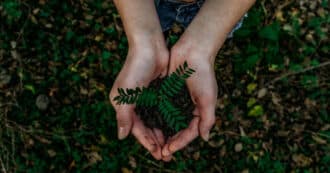By Sydney Cohen – Have you ever wondered why there is a need for sustainable development? The answer lies in population growth and natural resource depletion. To put it simply, the Earth has limited resources that cannot sustain an infinite number of people. This blog post will explore the principles of sustainable development to help increase your understanding of how to live more responsibly.
Natural Resources
Natural resources are natural assets that provide natural capital for the production of natural goods and services. In other words, natural resources are minerals or substances such as coal, water, wood, and air which can be used in the production process to make a product.
Natural resources include both renewable and non-renewable natural resources. Renewable natural resources will eventually run out if they’re not replaced by something else, but most people don’t worry about this because they think we have a lot of them on Earth. They include our forests, oceans, air, rivers, soil, grasslands, fisheries, etc. Non-renewable natural resources won’t last forever – like oil reserves that will one day run out once they have been used and they’re all gone from the earth’s surface.
Oil, coal, natural gases, metals, stone, and sand are all examples of natural resources that are found on earth. Other natural resources include soil, water, sunlight, and air, as well as plants and animals. Present and future generations rely on these natural resources for survival, which is why we must find sustainable methods of harvesting these resources in order to ensure environmental protection without compromising the ability of economic growth for future generations.
The Idea of Sustainable Development
The concept of sustainable development is not new. In fact, it has been around for a few decades and was formulated in 1987 by the Brundtland Commission as “development that meets the needs of the present without compromising the ability of future generations to meet their own needs.”
The concept comes from three core pillars, also known as the sustainable development principles: economic growth, social equity, and environmental protection. The idea behind these pillars is that they are mutually supportive; one cannot exist without the other two because humans have an infinite need for natural resources on this planet.
The term “sustainability” should be viewed as humanity’s target goal of human–ecosystem equilibrium, while “sustainable development” refers to the holistic approach and temporal processes that lead us to the endpoint of sustainability. When we start to understand how all three components work together to create a more sustainable world, then we can form our own concept about what it means to be an environmentally friendly citizen or business owner!
The History of Sustainable Development
The term ‘sustainable development’ was developed in 1972 at the UN Conference on the Human Environment. The Brundtland Report called “Our Common Future” was written in 1987. There have been multiple forums and conferences since the report was published, to check in on world progress working toward sustainability through sustainable development approaches.
In 2015, the United Nations adopted a plan of sustainable development with a set of guidelines, working toward making our planet more sustainable for future generations, allowing for economic growth and economic development while at the same time prioritizing environmental protection. This plan is known as the Sustainable Development Goals (SDGs). It follows the principles of sustainability, understanding the important intersections between society and quality of life, social and economic needs, the economic system, and the dangers of environmental degradation that result from our current exploitation of natural resources.
However, the concept of sustainable development has been, and is still, subject to criticism. Modern economies are still trying to reconcile ambitious economic development and obligations of preserving natural resources and ecosystems for future generations. The desired result of sustainable development is a state of society where living conditions and resources are used to continue to meet human needs without undermining the integrity of the natural system.
The Principles of Sustainable Development
As previously mentioned, the principles of sustainable development involve the intersection of societal sustainability, economic sustainability, and environmental sustainability. The sustainability of society depends on the availability of health, employment, and quality education. It is necessary to conserve all the living beings in the world. Population control and management are also essential for sustainable development. People can play a vital role in the utilization and conservation of the environment. Human resource contributes to adopting the principles of sustainable development. Public participation should be increased in every program.
Sustainable development focuses on biodiversity, cultural heritage, and cultural aspects of people. Its conservation supports the environmental balance. People cannot over-exploit natural resources to meet their needs for life and sustainability. People must keep the earth within the carrying capacity of the earth’s resources. The earth has limited resources, and we must protect them for future generations, which is why adopting sustainable development practices is vital to the success and longevity of society and human life.
One key principle of sustainable development hinges on the conservation of the ecosystem and biodiversity, production systems, population control, human resource management, conservation of progressive culture, and people’s participation. Sustainable development is built on the principle of participation, which requires positive attitudes of the people so meaningful progress can be achieved with responsibility.
Education and training can also influence society towards conserving the environment and appreciating human values as well as acceptable production methods.
Zero Waste As An Example Of Sustainability
The zero-waste movement is a lifestyle that encourages people to use all types of waste in a circular way. It follows a set of principles that are focused on waste prevention, encouraging circular resource life cycles, so as to limit waste as much as possible. The ultimate goal of this philosophy is to avoid resources to follow a linear route. For this, people must refuse what they don’t need, reduce what they’re getting, reuse, recycle or compost it.
The movement is also very well known by people taking their own containers to shops to buy commodities such as chickpeas, rice, or liquid soap. It also prioritizes the reusing of plastics, as plastic is one of the biggest threats to the ecosystems of our oceans.
Zero-waste requires “responsible production, consumption, reuse and recovery of all products, packaging, and materials, without burning them, and without discharges to land, water or air that threaten the environment or human health.” The zero-waste movement is an example of a sustainable development process that works toward environmental protection while at the same time allowing for economic growth since it creates new opportunities for businesses to generate money in a sustainable way by creating recyclable materials.
The 17 Sustainable Development Goals
The United Nations (UN) is an international organization that was founded on October 24, 1945. It has a membership of 193 countries and territories. One of its main goals is to promote sustainable development in poorer countries by providing humanitarian aid and working with other agencies.
On October 4th, 2015, the UN adopted 17 sustainable development goals. These goals are designed to be completed by 2030 and they will have a significant impact on every person in the world. According to Wikipedia, in August of 2015, 193 countries agreed to adopt the 17 goals:
- No poverty
- Zero hunger
- Good health and wellbeing
- Quality education
- Gender equality
- Clean water and sanitation
- Affordable and clean energy
- Decent work and economic growth
- Industry, innovation and infrastructure
- Reduce inequality
- Sustainable cities and communities
- Responsible consumption and production
- Climate action
- Life below water
- Life on land
- Peace and justice. Strong institutions
- Partnerships for the goals
These goals outline the steps of sustainable development needed to meet the long-term goal of a sustainable world. They include the principles of sustainable development that focus on the intersection between society, the economy, and the environment and work toward economic and environmental harmony. Sustainable production and consumption is also a vital aspect of sustainable development, as it, similar to the zero-waste movement, focuses on creating a circular life-cycle for consumable products, creating minimal waste.
Religion and the Principles of Sustainable Development
Peter Adriance of the Bahai faith gave a speech prior to the International Energy Forum (IEF) conference in 2011 entitled “Spiritual Principles for Sustainable Development.” In this speech he gives a powerful illustration of the importance of religion for sustainable development:
“In conceptualizing sustainable development, many people have compared it to a stool with three legs. There’s the environmental leg, the social leg and the economic leg. If any one of these legs is short or weak, the stool is not going to be very stable. In fact, it may even collapse. You need all three legs to be equally strong, to maintain balance. When the principles associated with each of these legs are spiritually based, it’s like reinforcing the legs of the stool. It is made even stronger.”
This beautiful image of sustainable development principles being reinforced by spirituality is a powerful reminder of the importance of religion in our sustainability work.
The Spiritual Qualities Necessary for Sustainable Development
Peter Adriance concludes his address with the following list of “spiritual qualities that go hand in hand with the transition to sustainability”:
- A deep sense of world citizenship
- A commitment to justice
- An inclination toward treating one another with love and compassion.
- A commitment to stewardship of the earth
- A willingness to sacrifice for the betterment of society.
- Moderation
- Detachment from the things of this world.
Becoming Conscious Humans
For each of us to recognize these spiritual qualities in our own traditions and bring them to bear on the environmental crisis we now face is essential in “reinforcing the legs of the stool” of sustainable development. We all need to individually become conscious in ensuring sustainable development, so that the earth is sustainable for us now and also for those to whom we will pass the torch. Individual change will have a ripple effect causing collective change for the good of all.
Taking Responsibility for Sustainable Development
We must work to reverse the environmental damage that we’ve caused by exploiting our natural resources, in order to provide for present and future generations without compromising the ability for their survival.
Understanding the principles of sustainable development is vital to ensuring the success of our environment, economy, and society. We can work together and share in the ability of future generations to work to save our planet from climate change through sustainable development processes, working to make our world a more sustainable place.
Educate Yourself and Others Towards Sustainable Development
Each of us has a responsibility to ensure that we are living sustainably. If you want help figuring out how to make your business more sustainable, or if you need guidance on the best ways for individuals and communities to contribute in order to reduce our environmental footprint, contact us , share this blog post and educate yourself and others as much as you can – knowledge is power!
* Featured image source







I learned a lot going through this write up